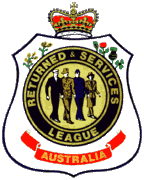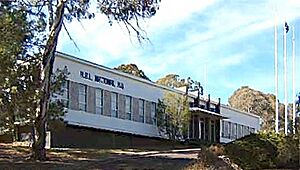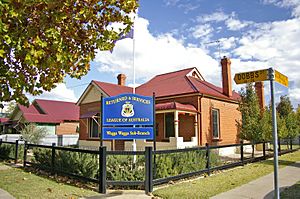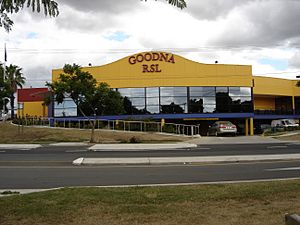Returned and Services League of Australia facts for kids
 |
|
| Abbreviation | RSL |
|---|---|
| Formation | 16 June 1916 |
| Type | Ex-service organisation |
| Registration no. | ACN 008 488 097 |
| Legal status | Charity |
|
Membership (2022)
|
147,671 |
|
National President
|
Major General Greg Melick, AO, RFD, SC |
| Phil Winter | |
| Affiliations | Royal Commonwealth Ex-Services League (RCEL) |
|
Formerly called
|
|
The Returned and Services League of Australia, known as RSL, is an important group that helps people who have served or are currently serving in the Australian Defence Force. This includes soldiers, sailors, and air force members.
The RSL works to support these brave men and women and their families. They make sure veterans get the care and help they need after their service.
Contents
History of the RSL: How it Started and Grew

The RSL was created in 1916, during World War I. Many Australian soldiers were returning home, and there wasn't enough support for them. They needed better medical care and help getting back to civilian life.
On June 6, 1916, representatives from different Australian states met. They decided to form a group called The Returned Sailors and Soldiers Imperial League of Australia (RSSILA). Their main goal was to fight for better conditions and support for veterans. They also wanted to help keep Australia safe.
Before this, smaller groups in each state tried to help veterans. But the RSSILA became the biggest and most important group for ex-service people in Australia.
Changes to the RSL's Name Over Time
The RSL's name has changed a few times.
- In 1940, it became the Returned Sailors', Soldiers' and Airmen's Imperial League of Australia (RSSAILA). This change included air force members.
- In 1965, it was shortened to the Returned Services League of Australia (RSL).
- In 1990, it became the Returned & Services League of Australia.
These changes helped include all service members. For example, before 1990, some who defended Darwin in World War II couldn't join because they hadn't left Australia. The RSL now welcomes all who served, no matter where.
Leaders of the RSL: National Presidents
The RSL has had many leaders since it began. These leaders are called National Presidents. They guide the organisation and speak up for veterans across Australia.
| National presidents | ||||
|---|---|---|---|---|
| Order | Rank | Name | Postnominals | Held office |
| 1 | Lieutenant Colonel | William Kinsey Bolton | CBE, VD | 1916–1919 |
| 2 | Captain | Sir Gilbert Dyett | CMG | 1919–1946 |
| 3 | Colonel | Sir Eric Millhouse | KC | 1946–1950 |
| 4 | Sergeant | Sir George Holland | CBE, MM | 1950–1960 |
| 5 | Lieutenant Colonel | Sir Arthur Lee | KBE, MC & Bar | 1960–1974 |
| 6 | Brigadier | Sir William Hall | KBE, DSO, ED | 1974–1978 |
| 7 | Captain | Sir William Keys | AC, OBE, MC | 1978–1988 |
| 8 | Brigadier (Retd) | Alf Garland | AM | 1988–1993 |
| 9 | Major General (Retd) | William Brian "Digger" James | AC, MBE, MC | 1993–1997 |
| 10 | Major General (Retd) | Peter Phillips | AO, MC | 1997–2003 |
| 11 | Major General (Retd) | Bill Crews | AO | 2003–2009 |
| 12 | Rear Admiral (Retd) | Ken Doolan | AO | 2009–2016 |
| 13 | Major | Rod White | AM, RFD | 2016–2017 |
| 14 | Warrant Officer | Robert Dick | 2017–2018 | |
| 15 | Major General (Retd) | Aziz Gregory "Greg" Melick | AO, RFD, SC | 2019–present |
How the RSL is Organised and What it Does
The RSL's main goal is to help Australia's veterans and their families. They want to make sure these families have good opportunities in all parts of their lives.
The RSL works to speak up for veterans across the country. They also create and support programs to help them.
RSL Structure: National, State, and Local Branches
RSL Australia is made up of many independent state groups. These state groups then have over 1,100 smaller local groups called sub-branches. Each sub-branch helps veterans in its local area.
The main RSL office is in Canberra. This office helps set the national plan for veterans' issues. It also supports and coordinates programs across Australia.
The RSL is a registered charity. It is run by a board of directors. This board includes the national president, state representatives, and other independent directors.
What the RSL Does for Veterans and Families

The RSL runs many programs to help its members and new generations of veterans. In 2022, some of their activities included:
- Speaking at hearings and writing detailed reports to help veterans.
- Starting a national forum to help different veteran support groups work together better.
- Actively speaking out on important issues for veterans. This includes asking for government help for Afghan interpreters, mental health support, and medical care.
- Organising major events like ANZAC Day and Remembrance Day ceremonies. They also support other important anniversaries.
- Helping to shape national discussions about security and defence.
- Working with government departments to help service members move into civilian life.
- Running a national program to help veterans find jobs.
- Restarting "RSL Active" to organise sports and fun activities for members.
The RSL's Role in Australian Society
The RSL has always been important in Australia. They helped create the traditions for ANZAC Day dawn services and marches. They also organise Remembrance Day events.
The RSL focuses on the well-being of Australian men and women who have served in the armed forces. They work to make sure veterans get their proper benefits. They also help protect old battlefields.
RSL members often help remember those who served their country. They share funeral information and hand out poppies at funerals.
RSL Membership: Past and Present
In the 1970s and 1980s, some veterans, especially those from the Vietnam War, felt the RSL wasn't very welcoming. Many RSL members at that time had served in World War II.
However, as fewer World War II veterans are around, Vietnam veterans and their families have become a big part of the RSL. The RSL now works hard to welcome all who have served.
Understanding the RSL Badge
The RSL badge is a special symbol. It shows that members are always ready to serve their country and help their fellow veterans. You cannot buy this badge. Only members can wear it.
- The shield on the badge shows how the RSL protects its members and their families.
- The crown at the top means loyalty to the King or Queen.
- Below the crown are the national flowers of Australia, Wales, England, Scotland, and Ireland: the wattle, leek, rose, thistle, and shamrock.
- In the middle, a sailor, soldier, airman, and service woman are marching with linked arms. This shows friendship and unity among all services and ranks.
- The red colour means the blood ties of war.
- The white background stands for pure motives and helping others without wanting anything in return.
- The blue means being willing to help a fellow veteran anywhere in the world.
RSL Branches and Clubs: What's the Difference?

Each state and territory in Australia has an RSL branch. These branches have smaller local groups called sub-branches. These groups help members in their local areas.
It can be confusing because there are also commercial places called "RSL Clubs." These are different from the RSL's sub-branches.
Licensed RSL Clubs: Places for Community and Support

Licensed RSL clubs started as places for sub-branches to offer services to their members. They were meant to be friendly places where veterans could meet and remember the ANZAC spirit. These clubs provided food and drinks and a place for comradeship.
Over time, these clubs became successful businesses. They often donate money to local community services.
Membership in a licensed RSL club is different from being a member of the RSL organisation itself. Being an RSL member doesn't automatically let you into a licensed club. However, some clubs offer honorary membership to serving members of the Australian Defence Force.

Licensed RSL clubs usually have bars and dining areas. They sometimes have gaming areas too. Every evening at 6:00 pm, the Ode of Remembrance is read, followed by one minute of silence. This honours those who died serving their country.
It's important to know that in New South Wales, the RSL organisation and its sub-branches do not own or run these licensed clubs. They also do not operate poker machines. However, in Victoria, some RSL sub-branches do run clubs.
Other Ways the RSL Helps
The RSL also has other activities that help raise money and support the community.
RSL Care: Helping Older Australians
The first RSL home for ex-servicemen opened in 1938. This group, which became RSL Care, grew to have many facilities. In 2016, it merged with another organisation and became Bolton Clarke. It is now one of Australia's largest providers of retirement living and aged care services. They have many retirement communities in Queensland and New South Wales.
RSL Art Union: Winning Prizes and Helping Veterans
The RSL Art Union started in Queensland in 1956. It's a lottery that raises money for welfare services. These services help ex-service men and women, their families, and others in the community.
Often, the main prize is a luxury home on Queensland's Gold Coast. The RSL Art Union has raised millions of dollars to help build and maintain RSL nursing homes, hospitals, and retirement complexes for older people.
See also
Similar Veterans' Organisations Around the World
- American Legion (USA)
- Australian Legion
- Royal British Legion (UK)
- Royal New Zealand Returned and Services Association (New Zealand)
- Royal Canadian Legion (Canada)
- South African Legion (South Africa)


